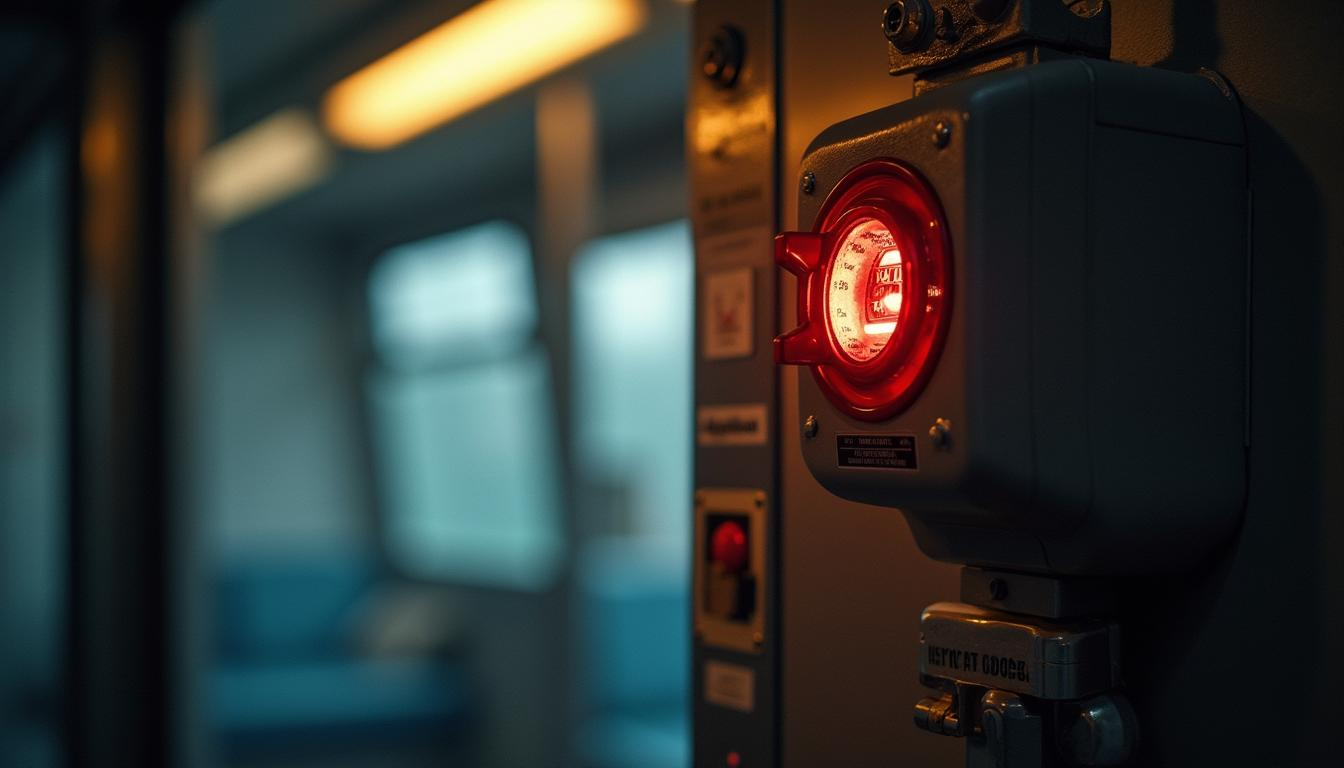Safety is the most important thing in any system that uses big tools or moving parts. In dangerous places, an operator’s lack of attention for even a second can cause crashes that are very bad or even deadly. That’s when a Dead Man control switch comes in handy. This technology makes operators stay on duty all the time and acts as a backup in case human attention fails.
There are many uses for a safety interlock switch in industry, and this piece talks about them. Engineers, safety inspectors, and practical managers need to understand this process to make sure they follow the rules and lower the risk on the job site.
What is a Dead Man Control Switch?
A Dead Man control switch is a type of safety switch that stops a machine or system from working if the person operating it goes away or stops paying attention. The name comes from the fact that the operators of trains had to keep pressure on the switch. If you let go of it, it would mean that the “man” was no longer there or aware, which would cause an instant stop.
Its primary goal is to act as a fail-safe switch, turning off machines or activities instantly when no one is in charge. This keeps possibly dangerous equipment from running on its own in case of an emergency, tiredness, or attentionlessness.
This very important gadget is also known as:
- Operator presence control
- Fail-safe switch
- Man present system
- Safety interlock switch
Many of these terms have slightly different meanings or operational approaches, but they all share the same goal: to ensure people are present as a prerequisite for operation.
How Do Dead Man Control Switches Work?
The Dead Man control switch is based on a simple but strong idea: it needs constant input from the user to keep working. If the operator touches, presses, or otherwise interacts with the switch, the machine or system will only work while the operator is doing so.
Although it may only be for a moment, if the operator releases the input, the system will assume that they are either not able to do their job or are not paying attention. This will cause an automatic stop or an emergency response.
There are different kinds of dead man switches that can have mechanical or computer triggers:
- Mechanical Foot Pedals: Often found on trains and forklifts. The person in charge has to keep one foot on the ground. Letting go of the pedal turns off the power or puts on the brakes.
- Hand Grips or Levers: The person using it has to hold on tight to the lever; if they let go, the machine stops working.
- Push-to-Run Buttons: To keep these machines going, the person operating them has to press and hold a button all the time.
- Proximity Sensors or Touch Plates: Today’s technology uses skin touch, body heat, or electrical interaction to show that someone is there.
There are these buttons built into the machine’s control system. When input is interrupted, the machine immediately starts shutting down, such as:
- Taking away the power
- Putting on the emergency brakes
- Setting off warning alarms
- Giving control rooms alerts
Because they don’t fail, they are necessary in safety-critical processes.
Industries Using Dead Man Control Switches
Many different types of businesses use Dead Man control switches because they require constant operator supervision to maintain safety. Businesses in these areas rely on these tools to mitigate risk, ensure compliance with safety regulations, and respond promptly in emergency situations. These switches are very important in the following fields:
Rail & Metro Systems
In rail and metro systems, people who run trains have to keep their foot or button pressed down all the time. If they pass out, the Dead Man control switch will not function, triggering an emergency stop. This is very important to keep accidents from happening on long hauls or subway travel when operators are tired or sick.
Marine Applications
Boats, ships, and subs all have Dead Man control switches built into the helm. When a person falls overboard, the switch either stops the ship or activates an emergency cutoff switch, allowing rescuers to work quickly. A kill-switch strap can also be used as a Dead Man device on jet skis and speedboats.
Aviation & Defence
Defense systems, flight simulations, and armed drones all need operators to be present. After losing input, these switches either turn off the machine or start an automatic safety procedure. They keep pulling and performing engine maintenance on the airplane ground support equipment.
Industrial Machinery & Construction
Dead Man control switches keep people from getting hurt by heavy machines like cranes, trucks, conveyor belts, and robotic arms. For instance, a person driving a lift truck must keep the pedals pressed down. If they don’t, the lift will stop itself, which lowers the risk of accidents at work.
Utilities & Nuclear
These switches ensure that important tasks, such as controlling valves or cooling systems, are never left unchecked in power plants and other facilities that generate electricity. A man-made system ensures that an operator is always monitoring all sensitive activities. This keeps the system from failing in terrible ways.
Key Benefits of Dead Man Control Switches
A safety interlock switch has many benefits that make safety, compliance, and operating integrity much better in many fields. Here are some of the main perks, broken down in more detail:
Fail-Safe Mechanism for Immediate Shutdown:
This feature’s ability to work as a fail-safe switch is its most important advantage. If the user stops responding because they are tired, or because of a medical emergency or something else, the switch stops the machine from working. This quick action reduces the risk of damaging equipment or injuring people, serving as a built-in safety measure during high-risk tasks.
Supports Regulatory Compliance:
Using a Dead Man control switch helps businesses follow strict safety rules set by groups like ISO, IEC, and OSHA. By using this gadget in important tasks, safety rules are not only talked about but also followed in real life. Automation that makes compliance easier also lowers liability in case of crashes or checks.
Minimizes Workplace Accidents:
The fact that these buttons only let people directly supervise the operation of systems lowers the chance of mistakes made by people. If the user lets go or gets sick, the machine stops working right away. This stops things from happening, like cars that get away, machines that move, or dangerous leaks. This cautious plan to stop accidents saves lives and lowers the cost of paying for damages.
Promotes Active Operator Engagement:
The switch makes sure that the operator stays awake and focused on the job at hand by needing constant interaction. This lowers the chance of inactive or careless watching, which encourages responsibility. Because of this, workers are more focused, and mistakes that happen when they lose focus are much less common.
Easily Integrates with Broader Safety Systems:
Adding an alarm, automatic braking system, or emergency lights to a Dead Man control switch makes it part of a bigger safety environment. Because the system doesn’t rely solely on people to assist in situations, this integration speeds up and improves the efficiency of incident response.
All of these benefits are crucial for making the workplace safer, more compliant, and better equipped to handle real-time operating risks.
Best Practices for Using Dead Man Control Switches
Installing Dead Man control buttons is not enough to ensure they function properly. Take a look at these best practices:
- Choose the Right Switch Type: Different settings need different controls, like foot pedals, handles, lanyards, or proximity sensors. Select the appropriate switch type for the machine and the user’s working style.
- Regular Testing and Maintenance: Plan to inspect switches on a regular basis to ensure they haven’t worn out or stopped functioning. Bad switches can make you feel safe when you’re not. Immediate repair of broken or nonresponsive switches stops operating risks.
- Ergonomic Placement: Ensure the switch is easily accessible and does not cause fatigue for the user. If the setting is wrong, it could cause a lot of false triggers or dangerous solutions. Ergonomic design lowers the chance of disengagement by mistake or user pain.
- Operator Training: Teach workers how the fail-safe switch works and what to do if it gets turned on by mistake or breaks down mechanically. Remind everyone that the switch is a safety interlock and how important it is to never skip or turn it off during operations.
- Integrate with Emergency Protocols: If you connect these switches to alarm systems, emergency lights, or communication devices, they form a strong safety environment.
For a deeper dive into how a Dead Man Control Switch works and its industrial applications, check out our detailed guide at AJV Tech
FAQs
What safety standards or certifications apply to dead man switches?
Dead Man switches are often governed by international safety standards such as:
- ISO 13849-1 (Safety of machinery)
- IEC 60204-1 (Electrical equipment of machines)
- EN 50126 (Railway applications)
- OSHA 1910 Subpart O (Machinery and machine guarding)
Compliance with these standards ensures the switch is safe, reliable, and properly integrated.
How often should a dead man control switch be tested or maintained?
Check these switches, if you want to:
- Once a week for dangerous or used every day machines
- Every month for backup systems
- Anytime there is a false start or a potential malfunction
Testing the safety switch on a regular basis makes sure it will work properly in a real situation.
What happens if a dead man switch fails — is there a backup system?
A lot of the time, there is duplication. As an example:
- If the main switch fails, a backup shutoff may go off.
- Warnings or alarms may let control offices know.
- When a system senses a switch failure, it can go to a safe state by default.
With redundant systems, there is no single point of breakdown that could put safety at risk.
What’s the difference between a dead man switch and an emergency stop button?
For a Dead Man control switch to keep working, it needs steady input. An emergency stop button is a device that you have to push by hand in clear situations. The Dead Man switch stops the machine before any incident happens, while the emergency stop stops it after the incident happens.
How is a dead man switch different from a vigilance control system?
A vigilance control system checks on the operator’s actions, like pressing buttons or moving the joystick, every so often. A Dead Man control switch, on the other hand, needs to be present all the time. Both are safety features, but they have different input needs (constant vs. occasional).

